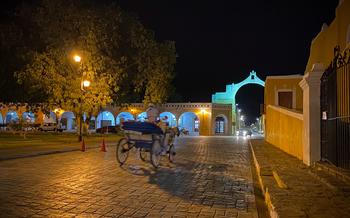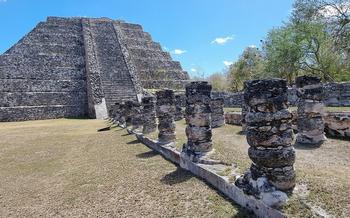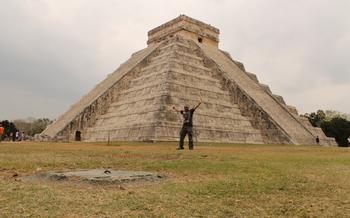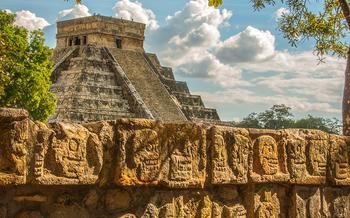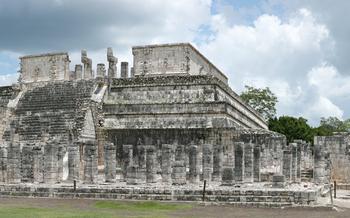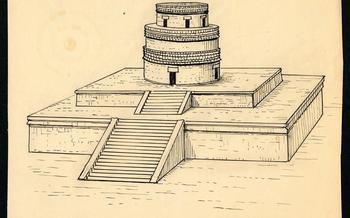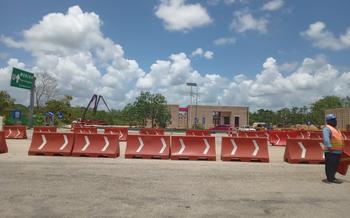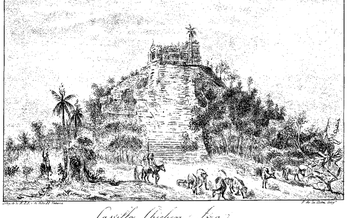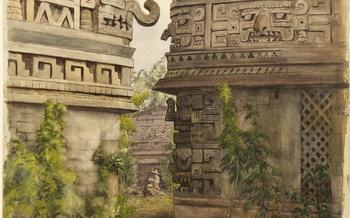
Mayapan Archaeological Site
- Mayapan Archaeological Site: A Glimpse into the Late Maya Civilization
- Exploring the Ruins: Unveiling the Secrets of Mayapan
- The Cocom Dynasty: Rulers of the Last Maya Empire
- The Round Structures of Mayapan: Unraveling their Mysteries
- The Cenote Ch'en Mul: A Sacred Water Source
- A Walk Through History: The Sacbeob of Mayapan
- The Fall of Mayapan: Unraveling the Mysteries
- Temple of the Masks: Embracing the Divine
- The Palace of the Governors: A Seat of Power
- The Ballcourt: A Realm of Ritual and Competition
- The Museum of Mayapan: Unveiling the Past
- Local Cuisine: A Taste of Mayan Flavors
- Cultural Performances: Embracing Maya Traditions
- Nearby Attractions: Exploring the Yucatan Peninsula
- Insider Tip: Unforgettable Sunsets at Mayapan
Mayapan Archaeological Site: A Glimpse into the Late Maya Civilization
The Mayapan Archaeological Site, located in the heart of the Yucatan Peninsula, Mexico, offers a glimpse into the fascinating world of the Late Maya civilization. Once the last major Maya city, it flourished between 1200 and 1450 AD and played a crucial role in shaping the region's history and culture. As you step into Mayapan, you'll be captivated by its unique architectural marvels, including round structures and a well-organized city layout. Delve deeper into its history and discover the rise and fall of the Cocom dynasty, the rulers who left an indelible mark on Mayapan's legacy. Practical information, such as location, hours of operation, and entrance fees, will help you plan your visit to this extraordinary archaeological site.
Exploring the Ruins: Unveiling the Secrets of Mayapan
Venturing into the heart of Mayapan, visitors are greeted by the Central Plaza, a sprawling expanse that once served as the city's bustling core. Towering over the plaza are the majestic temples and palaces, their imposing structures a testament to the grandeur of the Maya civilization. Among these architectural wonders, the Temple of Kukulcan stands out, a sacred pyramid dedicated to the revered feathered serpent god. Its intricate carvings and imposing presence evoke a sense of awe and reverence.
The Temple of the Warriors, another prominent structure within the city, captivates visitors with its elaborate facade adorned with intricate carvings depicting fierce battles and captured warriors. These graphic representations provide a glimpse into the martial prowess and military conflicts that shaped Maya history.
As visitors wander through the ruins, they encounter the Mercado, a vibrant marketplace where ancient Maya traders once gathered to exchange goods and ideas. Here, the remnants of shops and stalls hint at the bustling commercial activities that took place within this once-thriving center of commerce.
Exploring Mayapan's ruins is like embarking on a journey through time, where the tangible remnants of the past whisper tales of a once-great civilization. Each structure, each artifact, and each intricate carving holds clues to the lives, beliefs, and accomplishments of the Maya people who called this ancient city their home.
The Cocom Dynasty: Rulers of the Last Maya Empire
The Cocom dynasty emerged as a prominent ruling family in the Yucatan peninsula during the late Postclassic period. Their rise to power marked a significant shift in the political landscape of the Maya region, as they established their dominance over Mayapan and its surrounding territories.
The Cocom dynasty's leadership played a pivotal role in shaping Mayapan's political and economic development. They implemented effective governance structures, fostering stability and prosperity within the city. Through their alliances and conquests, they extended their influence over a vast network of Maya city-states, creating a powerful empire that rivaled the great Maya kingdoms of the past.
The Cocom rulers left a lasting legacy in Mayapan's architectural landscape. They commissioned the construction of unique round structures, fortifications, and temples, showcasing their power and prestige. These architectural innovations reflected their distinct style and contributed to Mayapan's distinctive appearance.
However, the Cocom dynasty's reign was not without challenges. Internal conflicts and external pressures eventually led to their downfall. The rise of rival Maya kingdoms, coupled with natural disasters and internal power struggles, weakened their grip on the empire. The Cocom dynasty's decline marked the end of Mayapan's dominance and ushered in a new era in the history of the Maya civilization.
The Round Structures of Mayapan: Unraveling their Mysteries
The round structures of Mayapan are one of the site's most distinctive features, setting it apart from other Maya cities. These unique buildings, unlike the more common rectangular or square structures found in Maya architecture, exhibit a remarkable circular design. The reasons behind this unconventional architectural choice remain a subject of fascination and debate among archaeologists and historians.
Architectural Uniqueness:
The round structures of Mayapan stand out for their circular shape, which is unusual in Maya architecture. They vary in size, with some measuring up to 10 meters in diameter. The walls of these structures are typically thick, providing stability and support to the circular form.
Functional Purposes:
The exact purpose of the round structures remains a mystery, but several theories have been proposed. Some scholars believe they served as residential units, providing shelter for the city's inhabitants. Others suggest they were used for ceremonial or religious purposes, perhaps as temples or shrines dedicated to specific deities.
Construction Techniques:
The construction of the round structures showcased the Maya's innovative building methods. They employed a unique technique called "corbel vaulting," in which each layer of stone gradually overlaps the one below, creating a self-supporting dome-like structure. This technique allowed the Maya to create large, enclosed spaces without the need for internal supports or columns.
Symbolism and Religious Significance:
The circular shape of these structures may hold symbolic or religious significance. The circle has been associated with various concepts in Maya culture, including the cosmos, the cyclical nature of time, and the unity of the universe. It is possible that the round structures were designed to reflect these beliefs and were used for rituals or ceremonies connected to these concepts.
The Cenote Ch'en Mul: A Sacred Water Source
In the heart of Mayapan lies a natural wonder of immense beauty and cultural significance – the Cenote Ch’en Mul. This ancient sinkhole, formed by the collapse of limestone bedrock, serves as a vital water source for the region and holds a deep spiritual meaning for the Maya people.
The cenote's crystal-clear waters, surrounded by lush vegetation, create a breathtaking sight. Its depth of over 20 meters invites visitors to take a refreshing dip and explore the underwater world teeming with diverse aquatic life. Snorkeling or diving in the cenote offers a unique opportunity to discover the intricate underwater cave systems and observe the resident fish, turtles, and other aquatic creatures.
Beyond its natural beauty, the Cenote Ch'en Mul holds immense cultural and historical significance. Archaeological excavations have revealed numerous artifacts and offerings within the cenote, suggesting its use as a sacred site for Maya rituals and ceremonies. These offerings, often consisting of pottery, jewelry, and other precious objects, provide valuable insights into the religious beliefs and practices of the ancient Maya.
In recognition of its cultural and ecological importance, the Cenote Ch'en Mul is now a protected natural area under the care of the Mexican government. Ongoing conservation efforts aim to preserve the cenote's pristine condition and ensure its continued availability for future generations. Visitors are encouraged to respect the fragile ecosystem and contribute to its conservation by following responsible tourism practices.
A Walk Through History: The Sacbeob of Mayapan
In the ancient Maya city of Mayapan, the sacbeob, or causeways, played a pivotal role in transportation and trade. These elevated roads, constructed with precision and ingenuity, connected Mayapan to other Maya cities and regions, facilitating the movement of people, goods, and ideas.
The sacbeob were engineering marvels, showcasing the Maya's advanced knowledge of construction techniques. Built using limestone blocks and covered with a layer of stucco, these roads were durable and designed to withstand the elements. Their elevated design allowed for efficient water drainage during the rainy season, preventing flooding and ensuring year-round accessibility.
The network of sacbeob extended beyond Mayapan, connecting the city to important centers like Chichen Itza and Uxmal. These causeways served as vital arteries for trade, enabling the exchange of goods such as agricultural products, ceramics, and obsidian. The sacbeob also facilitated cultural exchange, allowing for the spread of religious beliefs, artistic styles, and technological innovations.
Today, visitors to Mayapan can explore the remaining sacbeob, offering a unique opportunity to walk or bike along these ancient pathways. These causeways provide a glimpse into the sophisticated transportation system of the Maya civilization and serve as a reminder of their remarkable engineering achievements.
The Fall of Mayapan: Unraveling the Mysteries
The decline and eventual abandonment of Mayapan remain shrouded in mystery, with various factors contributing to its downfall. Internal conflicts and power struggles weakened the city from within, as different factions vied for control. External threats also played a role, with the rise of other Maya kingdoms, such as Chichen Itza, challenging Mayapan's dominance.
Natural disasters, such as droughts and hurricanes, further added to the city's woes. These events disrupted agriculture, leading to food shortages and economic instability. The combined impact of internal strife, external threats, and environmental challenges ultimately led to Mayapan's downfall.
Archaeological evidence provides clues to the city's demise. Excavations have revealed signs of violence and destruction, suggesting that Mayapan was not abandoned peacefully. The city's fortifications, once a symbol of its strength, were breached, and many buildings were burned or dismantled.
The fall of Mayapan marked the end of the Late Maya civilization and the beginning of a new era in the region's history. The Maya people dispersed to other parts of the Yucatan Peninsula and continued their traditions and culture, but the once-great city of Mayapan was left to ruins, a testament to the rise and fall of civilizations.
Temple of the Masks: Embracing the Divine
Among the impressive structures that adorn the ancient city of Mayapan, the Temple of the Masks stands out as a testament to the Maya's profound spiritual beliefs. This grand temple, with its imposing size and intricate carvings, was dedicated to various Maya deities, each holding a significant place in their complex pantheon.
The facade of the temple is adorned with a series of exquisitely carved masks, each representing a different deity. These masks, with their distinct features and expressions, seem to gaze out upon the surrounding landscape, silently guarding the sacred space within.
Archaeological findings within the temple have shed light on the religious practices and rituals that took place here. Artifacts such as incense burners, ceramic vessels, and jade offerings suggest that the temple was a site of devotion and prayer, where the Maya sought to connect with the divine realm.
Standing before the Temple of the Masks, one cannot help but feel a sense of awe and wonder. The intricate carvings, the imposing size, and the palpable spiritual energy that seems to emanate from the temple create an atmosphere of reverence and respect. It is a place where the Maya people came to honor their gods, to seek guidance, and to connect with the sacred forces that shaped their world.
The Palace of the Governors: A Seat of Power
As you wander through the ruins of Mayapan, make sure to visit the impressive Palace of the Governors, a testament to the power and prestige of the Cocom dynasty. This grand palace was the royal residence where the Cocom rulers lived and governed the city.
The Palace of the Governors stands out with its unique design and impressive dimensions. Its massive stone walls and intricate carvings showcase the architectural prowess of the Maya builders. Inside, you can explore the various rooms and chambers that once served as living quarters, meeting halls, and administrative offices.
The palace was not just a residence but also the administrative center of Mayapan. Here, the Cocom rulers managed the affairs of the city and the kingdom, overseeing trade, justice, and religious ceremonies. The palace served as a symbol of the Cocom dynasty's authority and power, reinforcing their position as the dominant force in the region.
As you walk through the palace, imagine the bustling activity that once filled these halls. Picture the Cocom rulers holding court, meeting with advisors, and making decisions that shaped the destiny of Mayapan. The palace stands as a reminder of the grandeur and sophistication of the Maya civilization, even in its decline.
The Ballcourt: A Realm of Ritual and Competition
Amidst the ruins of Mayapan, the imposing ballcourt stands as a testament to the deep cultural and religious significance of the ancient Maya game. This large, rectangular arena, carefully designed with sloped sides and stone markers, served as a sacred space for both ritualistic and competitive events.
The Maya ballgame, known as Pok-ta-Pok, transcended mere sport; it held profound spiritual and symbolic meanings. It represented the cosmic struggle between light and darkness, life and death, and the cyclical nature of existence. The game's outcome was believed to influence crop fertility, rainfall patterns, and the overall well-being of the community.
Archaeological evidence suggests that the ballcourt at Mayapan was meticulously constructed using limestone blocks and stucco. The court's dimensions and proportions were precisely calculated to facilitate the fast-paced and intricate gameplay, which involved two teams using their hips and elbows to propel a solid rubber ball through stone hoops mounted high on the walls.
Beyond its ritualistic significance, the ballcourt also functioned as a venue for intense competition and displays of athleticism. Skilled players, adorned in protective gear, engaged in fierce matches that drew large crowds of spectators. The outcome of these games carried great prestige and honor for the winning team and their community.
Today, visitors to Mayapan can explore this captivating ballcourt, imagining the electrifying atmosphere of ancient matches and marveling at the enduring legacy of the Maya game, a testament to the cultural and spiritual richness of this ancient civilization.
The Museum of Mayapan: Unveiling the Past
Nestled within the grounds of the Mayapan Archaeological Site, the Museum of Mayapan serves as a treasure trove of knowledge and artifacts that illuminate the rich history and culture of this ancient Maya city. Through its comprehensive collection of exhibits, interactive displays, and educational programs, the museum offers visitors a captivating journey into the past, allowing them to delve deeper into the mysteries of Mayapan.
The museum's carefully curated exhibits showcase a diverse array of artifacts unearthed during archaeological excavations at the site. These artifacts, ranging from intricate ceramics to finely carved sculptures, provide tangible evidence of the artistry, craftsmanship, and daily life of the Maya people who once inhabited Mayapan. Visitors can marvel at the intricate designs and motifs that adorn these objects, gaining insights into the symbolism and beliefs that shaped Maya society.
Interactive displays employ multimedia technology and hands-on experiences to engage visitors and bring the history of Mayapan to life. Through virtual reality simulations, visitors can virtually explore the ancient city, immersing themselves in its bustling streets and towering temples. Interactive touchscreens offer detailed information on the various aspects of Maya culture, including their writing system, astronomy, and religious practices.
The museum also offers a range of educational programs and resources tailored to visitors of all ages. Guided tours led by experienced archaeologists provide in-depth insights into the significance of the site and its artifacts, while workshops and lectures delve into specific topics related to Maya history and culture. Educational materials, such as books, pamphlets, and audiovisual presentations, are available for visitors to further their understanding of Mayapan and the Maya civilization.
Local Cuisine: A Taste of Mayan Flavors
As you explore the ancient ruins of Mayapan, take the opportunity to savor the delicious flavors of traditional Mayan cuisine. The Yucatan region boasts a unique culinary heritage that has been passed down through generations.
Local restaurants and markets offer a variety of traditional dishes that showcase the region's fresh ingredients and unique flavors. Try the classic cochinita pibil, a slow-roasted pork dish cooked in banana leaves, or indulge in the flavorful poc chuc, grilled pork marinated in a tangy citrus sauce.
For a truly authentic experience, consider taking a cooking class where you can learn the art of preparing traditional Mayan dishes firsthand. You'll discover the secrets behind the region's signature flavors and techniques, and you'll be able to recreate these delicious dishes back home.
Whether you're sampling local delicacies at a restaurant, trying your hand at cooking a Mayan feast, or simply enjoying a fresh fruit smoothie from a street vendor, the culinary delights of the Yucatan region are sure to tantalize your taste buds and leave you with lasting memories of your travels.
Cultural Performances: Embracing Maya Traditions
immerse yourself in the vibrant cultural heritage of the Maya people through captivating performances that showcase their traditions and way of life. Experience the mesmerizing movements and colorful costumes of traditional Maya dances, which tell stories of their history, mythology, and connection to nature.
The soulful melodies of live Maya music will transport you to another time as you listen to the rhythmic beats and enchanting sounds of traditional instruments. Immerse yourself in the captivating tales and legends that have been passed down through generations, sharing the wisdom and beliefs of the Maya people.
These cultural performances provide a unique opportunity to connect with the living traditions of the Maya culture and gain a deeper understanding of their rich heritage. Whether it's through dance, music, or storytelling, these experiences offer a glimpse into the heart and soul of the Maya people, leaving you with lasting memories of your time in Yucatan.
Nearby Attractions: Exploring the Yucatan Peninsula
The allure of the Yucatan Peninsula extends beyond the captivating ruins of Mayapan. A plethora of other ancient Maya cities, natural wonders, and cultural attractions beckon adventure-seekers and history enthusiasts.
-
Chichen Itza: Just a short drive from Mayapan lies one of the most iconic Maya cities, Chichen Itza. This sprawling archaeological site boasts towering pyramids, including the iconic El Castillo, a testament to the Maya's architectural prowess. The city's cenotes, such as the Sacred Cenote, hold a mystical allure, steeped in ancient rituals.
-
Uxmal: Another must-visit Maya city is Uxmal, renowned for its intricate and well-preserved architecture. The Governor's Palace, with its elaborate facades and corbelled arches, is a masterpiece of Maya craftsmanship. The Pyramid of the Magician, rising majestically above the jungle canopy, offers breathtaking views of the surrounding landscape.
-
Cenotes: The Yucatan Peninsula is dotted with cenotes, natural sinkholes that form enchanting swimming holes. These crystal-clear waters invite visitors to dive, snorkel, and explore the subterranean world. Cenote Ik Kil, with its stunning turquoise waters and lush vegetation, is a popular choice for a refreshing dip.
-
Valladolid: For a taste of colonial charm, make a stop at Valladolid, a picturesque city located near Mayapan. Wander through its cobblestone streets, admire the colorful colonial buildings, and visit the San Gervasio Cathedral, a testament to the city's rich history.
These nearby attractions offer a diverse array of experiences, complementing the wonders of Mayapan. Whether you seek further archaeological adventures, natural beauty, or cultural immersion, the Yucatan Peninsula promises an unforgettable journey through time and wonder.
Insider Tip: Unforgettable Sunsets at Mayapan
As the sun begins its descent towards the horizon, Mayapan transforms into a magical realm bathed in warm, golden hues. The ancient ruins cast long shadows across the landscape, creating a surreal and enchanting atmosphere. For a truly unforgettable experience, climb to the top of one of the temples and witness the breathtaking sunset views. The panoramic vistas of the surrounding countryside, dotted with lush vegetation and distant cenotes, are simply mesmerizing. Capture the beauty of this special moment with your camera and create memories that will last a lifetime. Whether you're a seasoned photographer or simply looking to soak in the wonder of nature, the sunsets at Mayapan are not to be missed.
